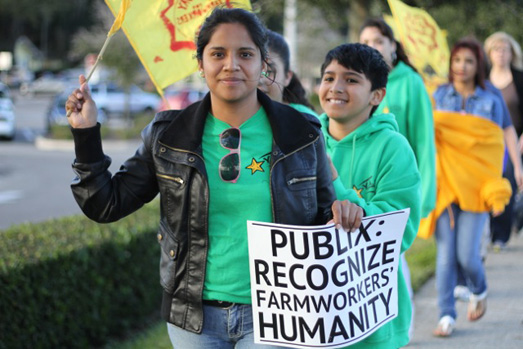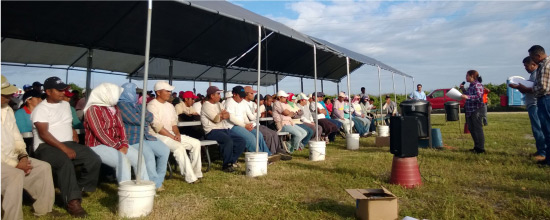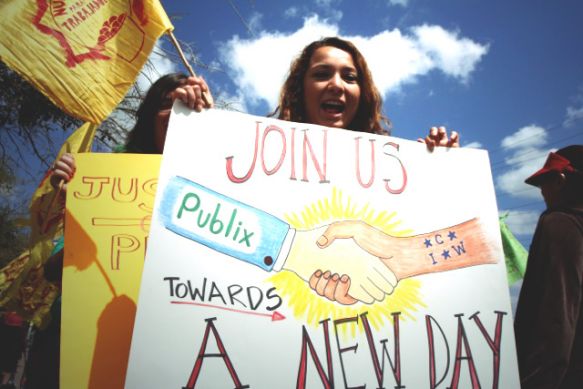[hupso title=”Tale of the tape: How the #FairFoodProgram measures up to #CSR” url=”https://ciw-online.org/”]
Worker-driven social responsibility puts workers first when addressing human rights in corporate supply chains…
If you are even a casual reader of this site you know this: The Fair Food Program has effected unprecedented change in Florida’s fields since it was implemented across 90% of the state’s tomato industry in 2011. It has eliminated or greatly reduced longstanding abuses from sexual harassment to modern-day slavery, added over $15 million in Fair Food Premiums to farm payrolls, and earned the praise of human rights experts from the White House to the United Nations. It has been called “one of the great human rights success stories of our day” in the Washington Post and “the best workplace monitoring program” in the US on the front page of the New York Times.
But even some of our most loyal readers might not know the “secret” behind the Fair Food Program’s success, even though the answer is deceptively simple: The Fair Food Program is a workers’ rights program that is designed, monitored, and enforced by the workers whose rights it is intended to protect. In the Fair Food Program, workers are not just at the table, they are at the head of the table. And because workers are the only actors in the supply chain with a vital and abiding interest in seeing that their rights are effectively monitored and enforced, they have, in the case of the Fair Food Program, constructed a system that actually works.
In short, the Fair Food Program is a truly new and distinct form of human rights program that can be called Worker-driven Social Responsibility (WSR). And thanks to the workers’ leading role in designing the program, its structure, function and, most importantly, results, stand in stark contrast to the traditional corporate-led approach to social responsibility, known by its acronym CSR.
What follows is a quick look at the differences between WSR and CSR along several key dimensions of social responsibility. The conclusion of that comparison is inescapable: If a human rights program is to be effective, the humans whose rights are in question must be key players in — the architects, not the objects of — the design and implementation of the program.
It starts with how the problem is defined: Public relations crisis (CSR) vs. Human rights crisis (WSR)…

We have established that the fundamental difference between Corporate Social Responsibility (CSR) and Worker-driven Social Responsibility (WSR) — the difference from which all other distinctions logically flow — lies in the question of who is at the helm. Does the corporation whose supply chain is riddled with human rights violations drive the program, or do the workers whose basic human rights are being violated on a daily basis? And the first difference between CSR and WSR that derives from this distinction is the very definition of the problem to be solved by the implementation of a social responsibility program.
In the case of CSR, in which corporations control the process, the problem to be solved is, almost invariably, a public relations crisis prompted by the revelation of gross human rights violations in a company’s supply chain. Factory fires in Bangladesh, suicides in Chinese assembly factories, slavery in Florida’s fields — all are examples of tragic human rights violations reflecting severely degraded labor environments that, though they had existed for years if not generations, had gone unaddressed by the brand name corporations connected to them until the inhumane conditions flared sufficiently to draw the attention of the press. The moment when 60 Minutes and the New York Times come knocking at executives’ door demanding an explanation for the abuses behind their company’s products is the moment when most CSR efforts are engaged in earnest. And the purpose of those efforts — the problem they set out to solve — is to ease the public relations crisis caused by the exposure of long-standing human rights violations. There are, of course, exceptions to this scenario, companies that take pre-emptive measures to ensure that their suppliers meet the highest human rights standards in their particular industries, but they are the exceptions that prove the rule.
In the case of WSR, on the other hand, the problem is defined entirely differently. It is the human rights crisis itself — not the public relations crisis to which it gives rise — that is the problem to be solved when workers themselves are at the helm. Unsafe factories, grinding poverty, being forced to work against your will or to perform sexual favors for your boss under the threat of violence — those are the conditions that workers set out to eliminate when they build a social responsibility program to reform their own workplaces. And those are the problems that the Fair Food Program was designed to detect and eliminate in Florida’s fields when it was put into place across the state three seasons ago.
Code of Conduct: Generic, corporate-drafted (CSR) vs. Specific, worker-crafted (WSR)…

In CSR, codes of conduct are called “Vendor Standards” and are generic across the dozens — or hundreds, or even thousands — of industries any given corporation may purchase from as part of its supply chain (supermarkets, for example, buy and sell thousands of products, while supermarkets/department stores sell still more). Corporations like to speak of their “robust” vendor standards, but rarely, when it comes to labor standards, do they require anything more of their suppliers than to comply with all applicable laws.
In WSR, workers craft industry specific codes of conduct that reflect the particular rights and reforms necessary to transform a brutal job into a more modern, more humane workplace. WSR codes contain provisions designed to get at longstanding abuses that only workers could know, the forms of exploitation and humiliation unique to each particular industry that workers have experienced for generations, but no outside “expert” could ever divine. In the case of the Fair Food Code of Conduct, there are numerous examples of such specific reforms that go above and beyond the law, from the elimination of the traditional requirement to overfill the picking buckets (“copete”) pictured above (a practice that resulted in workers effectively picking and hauling one unpaid 32-lb bucket or tomatoes for every ten for which they were paid), to the requirement to provide shade and time clocks in the fields, the right to leave the fields (without fear of being fired) if a worker feels that his or her health or safety is in danger, the prohibition against charging for housing to the extent it brings workers’ wages below minimum wage, and the penny-per-pound wage bonus, just to name a few.
No vendor standards drafted by an attorney working for Kroger in Cincinnati, Ohio, could ever contemplate the need for those reforms, and no code of conduct ever did, until workers in Immokalee finally won the opportunity to implement their blueprint for a fairer tomato industry, thanks to the Campaign for Fair Food.
Monitoring: Perfunctory and audit-based (CSR) vs. Participatory and complaint-based (WSR)…

When corporations monitor their supply chains (if they do at all), they do so through quick-hitting audits, perfunctory snapshots of working conditions taken over the course of a few hours or, at most, days, with little or no worker participation. The visits are either self-audits executed by an in-house team or — when a particularly acute public relations crisis requires that a company make a better show of its concern — third-party audits contracted out to one of dozens of professional auditing agencies that have come into existence over the past two decades to serve the needs of corporations facing increasing public scrutiny of their supply chain practices. In the vast majority of CSR efforts, the approach to monitoring is top-down, shallow, and momentary. As a result, CSR monitoring is a woefully ineffective means to get a measure of the intricate and often shadowy complex of human experiences, schemes, and interactions that make up the toxic workplaces at the end of far too many corporate supply chains.
In the WSR approach, workers themselves are the front line of a multi-layered, 24-hour, wall-to-wall monitoring system designed to capture violations of the code of conduct and weed out the bad actors and practices that cause those violations. In the Fair Food Program, for example, this is achieved through several key monitoring measures. Worker-to-worker education is carried out (on the clock) twice a season by teams of CIW members on farms around the state. The education program — combined with the distribution (at the time of hire) of a rights booklet and the viewing of a video produced by the CIW explaining the rights under the Fair Food code of conduct — is designed to ensure that each and every worker knows his or her rights and how to enforce them. A 24-hr complaint line, answered live by the same Fair Food Standards Council (FFSC) staffers who investigate the complaints, ensures that workers’ input is not ignored and helps identify and eliminate the sources of code violations. In the first three seasons of the FFP, nearly 600 complaints have been lodged under the FFP, the majority of which have helped carve, complaint by complaint, a more humane workplace out of a world once known as the “Harvest of Shame.” A strictly enforced zero tolerance policy for retaliation against workers has reinforced workers’ faith in, and use of, the FFP complaint process.
But the WSR approach is not solely complaint-based. The Fair Food Program also includes rigorous farm office and field audits carried out by the FFSC. And unlike CSR audits, FFP audits are in-depth events that exceed standard audit industry practices on many levels, most importantly on that of worker interviews. FFP auditors speak with a minimum of 50% of workers on any farm, with that number reaching as high as 90% or more depending on the size of the farm, while CSR audits hover around 10-20%. Further, FFP audits monitor not just outcomes, but the systems in place on the farms — or not in place, as was the case on the majority of farms when the program was launched in 2011 — that are necessary to make compliance even possible. Much of the work of the FFSC over the past three seasons has been guiding the growers through the restructuring of their supervisory, payroll, and management systems to allow for greater, more effective communication between workers and their employers and the elimination of longtime barriers to progress for farmworkers.
In short, workers are the lead actors in the monitoring of the Fair Food Program, from the education at the base of it to the auditing at the top, placing the job of monitoring human rights in the fields squarely in the hands of those who work in the fields.
Enforcement: Market-first (CSR) vs. Market-based (WSR)…

And that brings us to the last — and in practical terms perhaps most important — difference between CSR and WSR in this analysis: the enforcement of human rights standards.
For the vast, vast majority of corporations, getting goods to market, smoothly and without interruption, takes priority over protecting human rights in their suppliers’ operations. Lots of priority. Vast sums of money and human resources are directed toward effective and efficient supply chain management, while the social responsibility departments of most corporations are budgetary afterthoughts. This imbalance results in what can be termed a “market-first” approach to human rights, which in practical terms means that most corporations will, and do, go to great lengths to avoid cutting off relations with a favored supplier, even if it means turning a blind eye to sometimes horrific abuses.
As a result, CSR is, in practice, defined by a near total lack of enforcement. Publix spokesperson Dwaine Stevens’ famous words in response to a reporter’s question about forced labor in the grocery giant’s supply chain — “If there are some atrocities going on, it’s not our business” — captures this unpleasant reality with an admirable economy. Only the most overwhelming waves of bad publicity can dislodge a preferred supplier from most corporations’ supply chains. And that means that in most cases, once the media coverage and expressions of grave concern have ebbed, business as usual is, once again, the order of the day.
WSR is an entirely different way of doing business. In the case of the Fair Food Program, when egregious human rights violations — “atrocities” in Mr. Stevens’ terms, “zero tolerance violations” in the FFP code of conduct — are found on a farm, that farm is suspended from the program and the twelve participating buyers whose logos are pictured above must suspend purchases from that grower. No ifs, ands, or buts. The same goes for growers who refuse or fail to correct non-zero tolerance violations, as well. These certain and strict market consequences send an unmistakable message to the growers who operate under the Fair Food Program, a message that has fundamentally changed the Florida tomato industry in just three seasons, prompting observers to marvel at the transformation (from “In Florida Tomato Fields, a Penny Buys Progress,” New York Times, 4/24/14):
“When I first visited Immokalee, I heard appalling stories of abuse and modern slavery,” said Susan L. Marquis, dean of the Pardee RAND Graduate School, a public policy institution in Santa Monica, Calif. “But now the tomato fields in Immokalee are probably the best working environment in American agriculture. In the past three years, they’ve gone from being the worst to the best.”
*********

In summary…
Standards without proper monitoring aren’t even worth the paper they are printed on. And enforcement without the threat of consequences when suppliers fail to comply with those standards is simply impossible. CSR is characterized by shallow standards, ineffective monitoring, and a near total absence of enforcement.
WSR, on the other hand, is defined by the participation of workers at every level, from the setting of standards to their monitoring and enforcement. It was born in the tomato fields of Florida, and today elements of WSR are showing up in workplaces as varied as construction sites in Texas and apparel sweatshops in Bangladesh. It represents a potentially powerful new way of doing business that respects and protects human rights, not only in the US agricultural industry, but elsewhere in the country and around the globe.
© Coalition of Immokalee Workers
